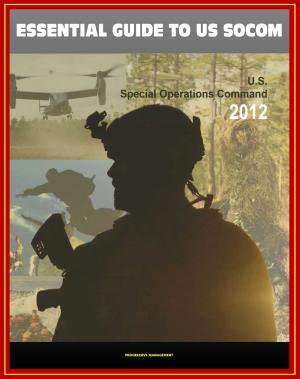Breaking the Mold: Tanks in the Cities - Five Case Studies: Sherman Tanks in World War II, Streets of Aachen, Pattons to the Rescue in Vietnam, Beirut in 1984, Grozny 1995, Fallujah in Iraq War 2004
Nonfiction, History, Military, Weapons, World War II| Author: | Progressive Management | ISBN: | 9781311071729 |
| Publisher: | Progressive Management | Publication: | April 17, 2016 |
| Imprint: | Smashwords Edition | Language: | English |
| Author: | Progressive Management |
| ISBN: | 9781311071729 |
| Publisher: | Progressive Management |
| Publication: | April 17, 2016 |
| Imprint: | Smashwords Edition |
| Language: | English |
This excellent report has been professionally converted for accurate flowing-text e-book format reproduction. This work examines the use of tanks in urban warfare. It seeks to provide insight and a historical precedence on the wisdom of employing tanks in an inherently dangerous dimension of the modern battlefield, intensifying the shortcomings in technological design and the lack of crew training for city fighting. Instead of being a legacy system ready for the scrap heap, tanks are still a vital component of the US Army, even in the streets.
Chapter 1 - Sherman Tanks in the Streets: Aachen, 1944 * The Westwall * Encircling Aachen * The Fight for Aachen * The Final Push In Retrospect * Chapter 2 - Pattons to the Rescue: Hue, Vietnam, 1968 * The Attack on Hue * Just Holding On * Pushing Back. * Battle of the Citadel * In Retrospect * Chapter 3 - Rock the Casbah: Beirut, 1984 * The Israeli Defense Forces * The Palestine Liberation Organization * Syrian Forces * The First Phase * Battle of Beirut * Into the City * In Retrospect * Chapter 4 - Headlong into Hell: Grozny, 1995 * Russian Order of Battle and Planning * Chechen Order of Battle and Planning * The Invasion * After Grozny * In Retrospect * Chapter 5 - Into the Maelstrom: Fallujah, November 2004 * Coalition Forces * The Plan of Attack * The Assault. * The Dust Settles * In Retrospect * Chapter 6 - Conclusion * Bibliography
During World War I, the tank was developed as an infantry support weapon to exploit breaches made in enemy lines. Technological limitations in speed, range, and mechanical reliability kept tank doctrine at the tactical level until the German offensives in 1939-40 showed that modern armored forces were a key element to the operational level of warfare. Yet, there was virtually no discussion of employing armor in the cities. Even famed military historian and early theorist of modern armored warfare John Frederick Charles Fuller seldom mentioned using tanks in urban terrain, and then only to dissuade their use. Avoiding the employment of armor in cities is a long-held trend that holds sway in most modern armies. Historically, battles for large cities are full of examples of high casualties and massive collateral damage, and the specter of a tank's easy destruction in the close confines of urban terrain weighs heavily on commanders and military planners. However, in a historical context, the vulnerability of armor in cities is proven to be overestimated and outweighed by the ability of the tank to bring its heavy firepower to the urban fight.
Military operations on urbanized terrain (MOUT) are not new to the US Army. World War II has numerous examples of US military personnel fighting in cities. What is new is the increasing use of tanks and other armored combat vehicles in cities. What was once considered taboo is now becoming commonplace because of the worldwide demographic shift of rural populations to cities. Some analysts estimate that by 2010 over 75 percent of the world's population will live in urban areas, thus shifting the future battlefields to within their limits. Additionally, the requirement to conduct stability and support operations will require the occupation of cities, whether large or small. Future military leaders will not have the luxury of avoiding Sun Tzu's axiom, "The worse policy is to attack cities. . . . Attack cities only when there is no alternative."
This excellent report has been professionally converted for accurate flowing-text e-book format reproduction. This work examines the use of tanks in urban warfare. It seeks to provide insight and a historical precedence on the wisdom of employing tanks in an inherently dangerous dimension of the modern battlefield, intensifying the shortcomings in technological design and the lack of crew training for city fighting. Instead of being a legacy system ready for the scrap heap, tanks are still a vital component of the US Army, even in the streets.
Chapter 1 - Sherman Tanks in the Streets: Aachen, 1944 * The Westwall * Encircling Aachen * The Fight for Aachen * The Final Push In Retrospect * Chapter 2 - Pattons to the Rescue: Hue, Vietnam, 1968 * The Attack on Hue * Just Holding On * Pushing Back. * Battle of the Citadel * In Retrospect * Chapter 3 - Rock the Casbah: Beirut, 1984 * The Israeli Defense Forces * The Palestine Liberation Organization * Syrian Forces * The First Phase * Battle of Beirut * Into the City * In Retrospect * Chapter 4 - Headlong into Hell: Grozny, 1995 * Russian Order of Battle and Planning * Chechen Order of Battle and Planning * The Invasion * After Grozny * In Retrospect * Chapter 5 - Into the Maelstrom: Fallujah, November 2004 * Coalition Forces * The Plan of Attack * The Assault. * The Dust Settles * In Retrospect * Chapter 6 - Conclusion * Bibliography
During World War I, the tank was developed as an infantry support weapon to exploit breaches made in enemy lines. Technological limitations in speed, range, and mechanical reliability kept tank doctrine at the tactical level until the German offensives in 1939-40 showed that modern armored forces were a key element to the operational level of warfare. Yet, there was virtually no discussion of employing armor in the cities. Even famed military historian and early theorist of modern armored warfare John Frederick Charles Fuller seldom mentioned using tanks in urban terrain, and then only to dissuade their use. Avoiding the employment of armor in cities is a long-held trend that holds sway in most modern armies. Historically, battles for large cities are full of examples of high casualties and massive collateral damage, and the specter of a tank's easy destruction in the close confines of urban terrain weighs heavily on commanders and military planners. However, in a historical context, the vulnerability of armor in cities is proven to be overestimated and outweighed by the ability of the tank to bring its heavy firepower to the urban fight.
Military operations on urbanized terrain (MOUT) are not new to the US Army. World War II has numerous examples of US military personnel fighting in cities. What is new is the increasing use of tanks and other armored combat vehicles in cities. What was once considered taboo is now becoming commonplace because of the worldwide demographic shift of rural populations to cities. Some analysts estimate that by 2010 over 75 percent of the world's population will live in urban areas, thus shifting the future battlefields to within their limits. Additionally, the requirement to conduct stability and support operations will require the occupation of cities, whether large or small. Future military leaders will not have the luxury of avoiding Sun Tzu's axiom, "The worse policy is to attack cities. . . . Attack cities only when there is no alternative."















